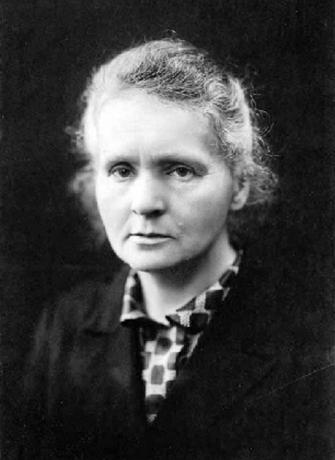Marie Curie she was one of the women to change the history and direction of the study of radioactivity, as well as showed the world the intellectual value and the rich contribution that women can provide to the scientific world, which was once predominantly male in character.
Marie Curie went to first person to receive the Nobel Prize twice, one inPhysics, by demonstrating the existence of natural radioactivity in 1903, and the other in Chemistry, for the discovery of two new chemical elements in 1910.
Since childhood, Marie Curie learned to face and overcome challenges imposed by society and living conditions, being a great example as a scientist for men and, especially, for women, as it showed that they are capable of promoting discoveries as much or more important.
Read too: Robert Boyle - The Alchemist Chemist
Marie Curie Biography

Marie Curiewas born on November 7, 1867, in the city of Warsaw, Poland. Her Christian name was Maria Sklodovska, surname inherited from her father, teacher of
Math and Physics, who became a school principal years later. Her mother, also a teacher, only participated in her education until she was 11 years old, when she died.Born in a home where science was the center of the family, Marie Curie she was always interested in the knowledge and, with the intention of producing it, she wanted to pursue a university career.
Living in a country dominated by the Russia tsarist, who in no way allowed women access to formal education, Marie Curie, on several occasions, set up clandestine study groups to be able to study and promote knowledge to other people.
In 1891, with the financial help of her father, Marie Curie managed to move to Paris, where joined the degree course in Physics of the Faculté de Sciences, which she completed in 1893. In 1894, she also completes the Mathematics course..
During her search for a topic and an advisor for her doctorate, Marie met Physics professor Pierre Curie, whom she eventually married in 1895. The two had two daughters, Éve and Irène.

Marie Curie died in 1934, victim of a leukemia, as a result of all the radiation exposure she was subjected to during her scientific and academic career.
Main contributions by Marie Curie
In your doctoral thesis, Marie Curie chose the theme uranic rays, radiation that had been discovered by the English physicist Becquerel. in her work, she managed to prove that the oxide of uranium is a mineral capable of eliminating radiation stored in atoms.
From this research, Marie Curie discovered radioactivity, since Becquerel did not continue his studies with uranium. Marie and Pierre Curie continued to look for other minerals in nature that might also have radioactive activity. In these researches, they developed a laboratory technique called fractional crystallization, which consists in heating a material to high temperatures and gradually cooling it down.

In 1898, Marie and Pierre Curie introduced to the scientific world the discovery of two new chemical elements, polonium and the radio. With these researches, Pierre, in particular, found that radiation could kill cells of diseased tissue, that is, he started the study of radiotherapy.

After Pierre's death in 1906, Marie went on to teach and also continued to carry out various research. One of them, extremely important, was the development of a radiograph, an X-ray equipment that was used during the First World War.
See too: Dynamite - explosive apparatus invented by Alfred Nobel
Memory
For her scientific contribution and persistence, Marie Curie is still well remembered and cited in scientific meetings, conferences or academic journeys. In addition, there are several hospitals and centers that bear his name, such as the Curie Institute, which helps train several new scientists every year. It is noteworthy that a chemical element, discovered in 1944, called Curium (Cm), atomic number 96, was named in tribute to the Curies, Marie and Pierre.
By Diogo Lopes Dias
Chemistry teacher
Source: Brazil School - https://brasilescola.uol.com.br/quimica/maria-curie-descoberta-radioatividade.htm

